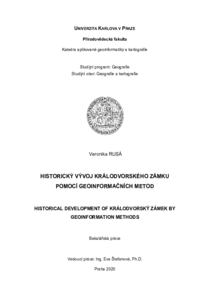Historický vývoj Králodvorského zámku pomocí geoinformačních metod
Historical development of Králodvorský zámek by geoinformation methods
bakalářská práce (OBHÁJENO)

Zobrazit/
Trvalý odkaz
http://hdl.handle.net/20.500.11956/118510Identifikátory
SIS: 219186
Kolekce
- Kvalifikační práce [21483]
Autor
Vedoucí práce
Oponent práce
Čábelka, Miroslav
Fakulta / součást
Přírodovědecká fakulta
Obor
Geografie a kartografie
Katedra / ústav / klinika
Katedra aplikované geoinformatiky a kartografie
Datum obhajoby
23. 6. 2020
Nakladatel
Univerzita Karlova, Přírodovědecká fakultaJazyk
Čeština
Známka
Výborně
Bakalářská práce se zabývá 3D rekonstrukcí, vizualizací a následnou prezentací objektu pomocí geoinformačních metod. Cílem práce bylo vytvořit 3D model zámku v Králově Dvoře ve 3 časových období na základě nalezených dat. Pro rekonstrukci bylo využito historických fotografií, stavební dokumentace a dalších datových podkladů. Při tvorbě 3D modelu byla snaha o co nejvěrnější vystižení podoby zámku a jeho nejbližšího okolí. Dalšími cíli byla vizualizace modelů a jejich prezentace v prostředí webu. Vedlejšími cíli byly dvě literární rešerše věnující se problematice 3D modelování. V teoretické části jsou popsány metody 3D modelování, druhy 3D modelů a jejich využití, teorie 3D a digitálních modelů terénu a interpolační metody. V praxi byly vytvořeny 3 modely zachycující zámek před rokem 1253, 1970 a v roce 2020 ve SketchUp, vizualizace proběhla v softwaru Lumion. Výsledkem jsou průletové animace a modely prezentované na webu Theasys. Obrazové výstupy jsou pak dále porovnány s historickými fotografiemi.
This thesis deals with 3D reconstruction, visualization and subsequent presentation of object using geoinformation methods. The aim was to create a 3D model of the Králův Dvůr castle in three time periods based on data found. Historical photographs, construction documentation and other data were used for the reconstruction. When creating the 3D model, an effort was made to capture the appearance of the castle and its immediate surroundings as faithfully as possible. Other goals were the visualization of models and their presentation on a website. The secondary objectives were two studies of literature dealing with the issue of 3D modeling. The theoretical part describes the methods of 3D modeling, types of 3D models and their use, the theory of 3D and digital terrain models and interpolation methods. In practice, 3 models were created capturing the castle before 1253, 1970 and in 2020 in SketchUp, the visualization took place in Lumion software. The results are fly-through animations, and models presented on the Theasys website. The image outputs are further compared with historical photographs.
